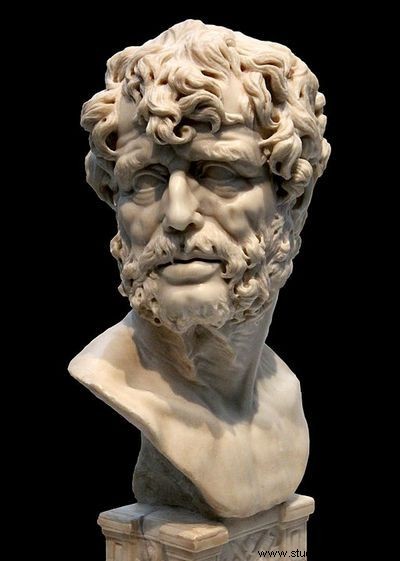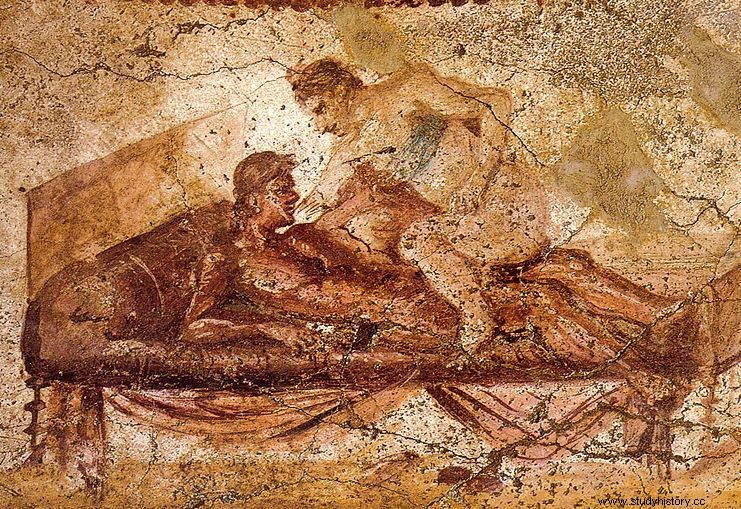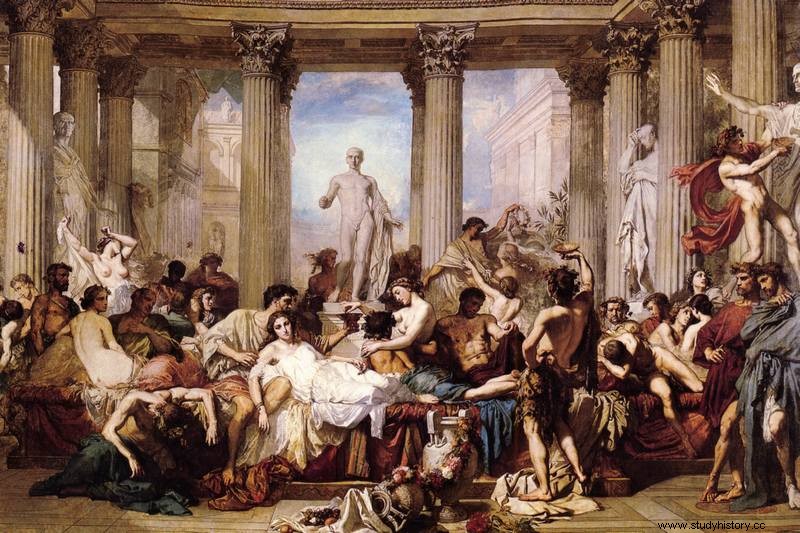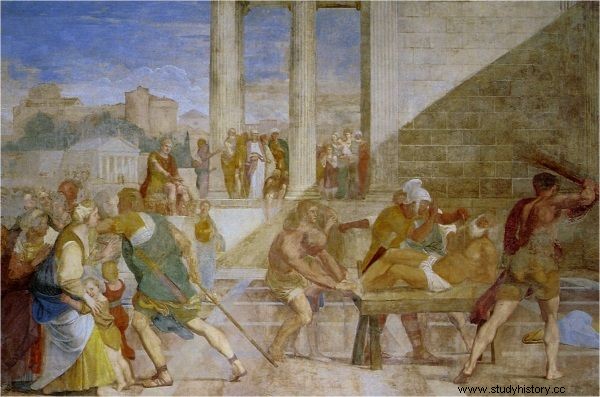Varro claimed that the slave is only a talking tool and has no right to any time off. It is not surprising:if he saw objects in the people he bought, he treated them that way. After all, none of us thinks about how to please our vacuum cleaner.
You didn't even have to find a similar heartless person to have a completely spoiled life. The pragmatic Kolumella, who believed that every free moment of a slave was best filled with work… because people learn to do wrong by doing nothing. Only the very lucky ones got time off from time to time. Usually not for the goodwill of the master, but for completely cynical reasons. The owners hoped that a minimum of freedom would increase the morale and quality of work of talking tools . The question is - what was the slave actually doing when he was not working?
A little wine, a little fun
In the countryside, a slave could find a free moment usually only after an evening meal. There was not much of that time. A maximum of two hours for relaxation and games, washed down with a little wine, scarcely dosed, so that the atmosphere does not become too relaxed and, as a result, there are no arguments or fights.
A privileged slave could even count on feasting at his master's table, which was allowed, for example, by Seneca the Younger. However, he himself noted that in his day (1st century CE) such an attitude was still considered by many to be outrageous.

If you had an understanding master (such as Seneca the Younger), the slave could even get the honor of sitting at the same table with his owner. The photo shows the bust of Seneca the Younger (photo:Dennis Jarvis; license CC ASA 2.0).
When it got dark for good, some slaves could barge. Sex, which could be a source of entertainment for a slave, was a potential source of income for his master. Roman law made every man born of a slave a slave, the property of the master of that slave (we wrote more about it in another article) . Kolumella himself encouraged his slaves to mate by granting freedom to everyone who gave birth to three sons.
If there was a day off from work - which was very rare - the slave could, for example, spend it hunting, which was also a form of entertainment. Free time, and certainly entertainment, could have been forgotten by a slave who lived during the great conquests of Rome (1st century BCE), when the supply was so large and the prices for the slave were so small that they were treated as a disposable commodity, exploited until limits, and when it was used up (read:died) it was replaced with a new one.
Craps, gambling and prostitutes
As a rule, life in cities was better. Columella considered the city slaves sluggish, lazy, accustomed to gambling, theaters and brothels . So they were people who had not only free time, but also money to pay for drinks and the company of prostitutes.

According to Kolumell, the slaves of the cities were used to gambling, theaters, and brothels. Pictured is a fresco from a brothel in Pompeii (source:public domain).
No wonder, then, that in response to Columella's complaints, Marcus Sidonius Semp * advises the slave owner:
Also, under no circumstances should you let your city slaves get used to venturing into the city center and wandering aimlessly. Before you know it, they'll join this lazy and sluggish group of slaves, used to idleness, hanging around the Field of Mars, Circus Maximus and theaters, gambling, wasting time in bars and taverns, and even lazing around in lupanars .
In his view, it is even dangerous to allow slaves to associate in societies for the lower classes. Contrary to appearances, they were not only funeral directors and often transformed into political assemblies, which were the source of future riots.

Saturnalia, lasting up to a week, brought with it a real explosion of freedom with entertainment. Pictured is a 19th century painting by Thomas Couture (source:public domain).
One week of freedom
The real burst of freedom with amusements was at Saturnalia. It was a celebration of equality and reconciliation in December, which lasted for several days and not infrequently for a week (December 17-23). At that time, it was not the origin or customs that mattered, they allowed coarse jokes, the streets were full of artists and jugglers, it was, as Marek Sidoniusz Semp writes:
More than just a regular holiday. That's when the whole world is turned upside down. What is normally considered good behavior is reversed so that blasphemous, coarse, indecent and drunken behavior is considered appropriate .

Learn the true history of ancient slaves in Mark Sidonius Semp's book "Train your slaves" (Horizon Mark 2015).
As a result, it was also the only period when slaves could behave completely freely. As if they were free people:
Even a shy, homegrown slave is not afraid to look an edile in the eye and throw dice in the face. Slaves cannot be punished, they are even allowed to speak out about their masters.
Indeed it is your job as master to wait for them at the table at the Saturnalia feast. The household is assigned more wine. Men dress up as women. The slave chooses the jester king's outfit for this evening, puts on his cloak and crown, and gives all ridiculous orders:"Ride the cook like the back of a horse!" or "Everyone drinks wine by three fingers!"
At that time, Pliny the Younger preferred to retreat to the privacy of his office, so as not to enter the parade of domestic slaves. He did this because the celebration did not give him pleasure, and the free slaves felt not being under the supervision of the master. Marcus Sidonius does not approve of such behavior, in his opinion the master should join the slaves, become a simple man, thus improving their mood and alleviating their daily misery.

Despite the freedom that prevailed during Saturnalia, the slave had to be careful about what he was doing, because after its completion, he could face severe punishment from his master (source:public domain)
But slaves should be wary. After Saturnalia, the owner became their master again, and had the right to punish a slave who, in his opinion, went too far during the celebration.
For slave owners, Saturnalia also had an educational dimension. Thanks to them, their subordinates could see a grotesque world where all norms have been reversed, there is chaos and absurdity, the duration of which could lead to ruin. But whether the slaves drew similar conclusions from this lesson, here is a completely different matter ...
Annotation:
* Mark Sidonius Semp is in fact the British historian Dr. Jerry Toner - playing the role of an ancient slave owner and writing a stylized guide based on a wide database of authentic sources from the period.
Bibliography:
Sources:
- Marek Porcjusz Katon, About the farm , trans. Łoś S., Wrocław, 2006.
- Marek Tuliusz Cicero, On rights , trans. Żółtkowska I., Kęty, 1999.
- Luciusz Juliusz Moderatus Kolumella, On agriculture , translated by Mikołajczyk I., vol. I, Wrocław 1991, vol. II, Toruń 1991
- Marek Terencjusz Warron, About the farm , trans. Ireneusz Mikołajczyk, Wrocław 1991
Studies:
- Bieżuńska-Małowist I., Małowist M., Niewolnictwo , Wrocław, 1987.
- Grant M., Gladiators , Łódź, 1987, Wrocław 1979.
- Kunderewicz C., Roman Private Law , Łódź, 1995.
- Schumacher L., Ancient slavery. A weekday and the fate of slaves , Poznań, 2005.
- Semp Mark Sidonius *, Train your slaves ... or the ancient art of management , Znak Horyzont, Krakow 2015.
- Winniczuk L., People. Traditions. The customs of ancient Greece and Rome , part II, Warsaw, 1985.
- Zabłoccy M. and J., Act on XII tables. Translation-text-explanations , Warsaw, 2003.
- Bradley K., Cartledge P. (ed.), The Cambridge World History of Slavery , Volume 1. The Ancient Mediterranean World , Cambridge 2011.
- Dyson, Stephen L. Rome:A Living Portrait of an Ancient City. Baltimore:The John Hopkins University Press, 2010.
- Joshel, Sandra R. Slavery in the Roman World . Cambridge:Cambridge University Press, 2010.
